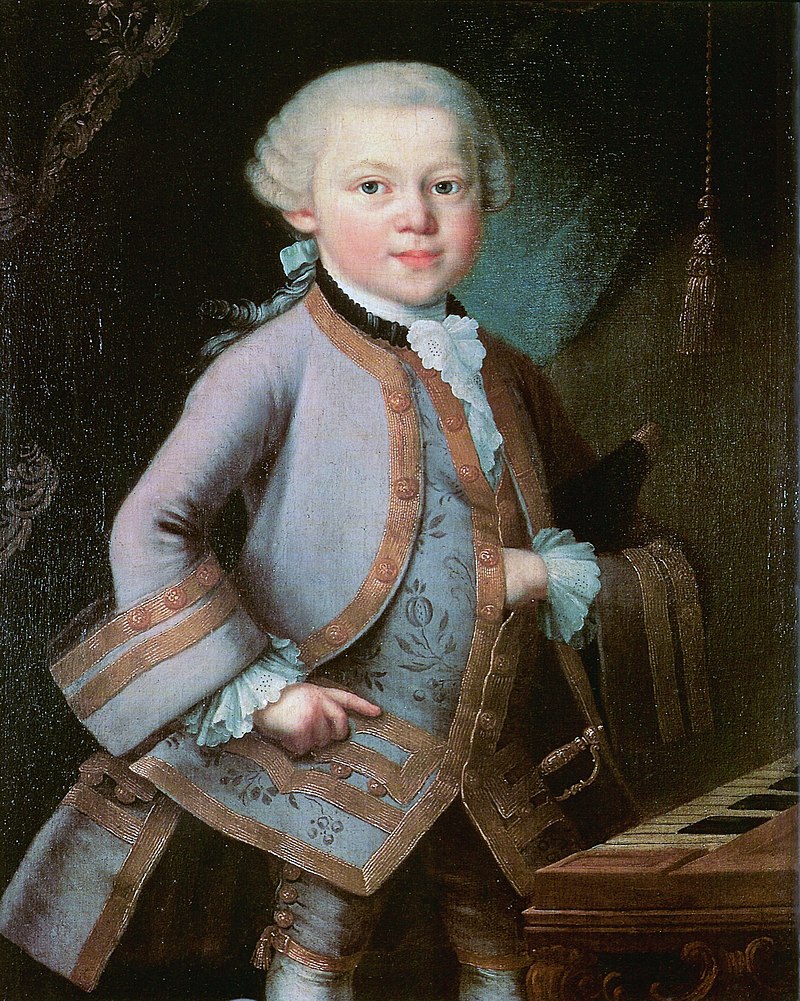|
| Project 366 continues in 2017-18 with "Time capsules through the Musical Eras - A Continued journey through the Western Classical Music Repertoire". Read more here. |
Wolfgang
Amadeus Mozart (1756-1791)
Wolfgang Amadeus Mozart, baptised as Johannes
Chrysostomus Wolfgangus Theophilus Mozart, was a prolific and influential
composer of the Classical era. Mozart showed prodigious ability from his
earliest childhood. Already competent on keyboard and violin, he composed from
the age of five and performed before European royalty.
At 17, he was engaged as a court musician in Salzburg, but
grew restless and travelled in search of a better position, always composing
abundantly. While visiting Vienna in 1781, he was dismissed from his Salzburg
position. He chose to stay in the capital, where he achieved fame but little
financial security. During his final years in Vienna, he composed many of his
best-known symphonies, concertos, and operas, and portions of the Requiem,
which was largely unfinished at the time of his death. The circumstances of his
early death have been much mythologized. He was survived by his wife Constanze
and two sons.
Full Biography - http://www.bach-cantatas.com/Lib/Mozart-Wolfgang-Amadeus.htm
He composed over 600 works, many acknowledged as pinnacles
of symphonic, concertante, chamber, operatic, and choral music. He is among the
most enduringly popular of classical composers, and his influence on subsequent
Western art music is profound.
Complete Works Catalog - http://www.musiqueorguequebec.ca/catal/mozart/mozwa.html
Mozart Listener Guides
Listener Guide
#154 – “Walter
Gieseking Plays Mozart”
Mozart left us with a rich catalog for the solo piano as
well as 27 “numbered” piano concertos and chamber works that place the piano in
a predominant role. The Mozart catalog features 18 “numbered” sonatas for solo
piano, as well as a handful or more of sonatas for piano four hands or two
pianos. This Listener Guide offers six Mozart sonatas from the “front nine” of
the series, nos. 1, 2, 5, 6, 7, and 9 composed between 1774 and 1777. (Once Upon the Internet # 37 – 19 May 2015)
(More Mozart Sonatas in Listener
Guides #4 and 12)
Listener Guide
#155 - “Viviana
Sofronitsky & Mozart”
This Listener Guide is a convergence of sorts – Mozart and
“old keyboards”, the latter having been the subject of a listener guide in Part
Ione of this project. I have retained here four of Mozart’s keyboard concertos;
the first (no. 2) is performed on the harpsichord and the remaining three (nos.
5, 6 and 11) are performed on the fortepiano. (ITYWLTMT
Montage #262 – 21 October 2017)
Listener Guide
#156 – “Mozart
2-3-4”
This Listener Guide is a further sampling of Mozart’s many
concertos for solo instrument and orchestra, featuring three instruments – the
horn, the violin and the piano. As I often due, allow me a little numerical fun
as the works follow the numerical sequence 2, 3 and 4.
Listener Guide
#157 – “Mozart
Concertos on MP3.COM”
Mozart’s four Horn Concertos (along with Haydn’s and the
pair by Richard Strauss) are a major part of most professional horn players'
repertoire. The concertos were written for his friend Joseph Leutgeb, whom he
had known since childhood. Most of us are familiar with the K. 495 finale, a
"quite obvious example of the “hunt” topic. Two of the four concertos are
featured in this Listener Guide, along with the Piano Concerto No. 8, also
known as the “Lützow”, a contemporary work to the Haffner Serenade (more
on that shortly…) (Once Upon the Internet # 4 – 18 Sept 2012)
(More Mozart Conerrtos in
Listener Guides #91, 116 and 118)
Listener Guide
#158 – “It’s
Haffner Time”
In the old town of Salzburg, along the left bank of the
Salzach between the Franciscan Church and City Hall you wi;l find the Sigmund
Haffner Gasse. It was named after Sigmund Haffner the Elder, mayor of Salzburg
from 1768 to 1772. This Listener Guide is dedicated to a pair of works that
were commissioned from Mozart by that prominent Salzburg family.
Listener Guide
# 159 – “Mozart's European vacation”
This Listener Guide features three Mozart symphonies that
are named after European cities: Paris, Linz and Prague (ITYWLTMT
Encore – 17 July 2015)
Listener Guide
#160 – “Michael
Haydn & Mozart“
This Listener Guide proposes as its key work one of Mozart’s
numbered symphonies that should be rightly assigned to Joseph Haydn’s brother;
the so-called Symphony No. 37 adds an introduction by Mozart to a symphony in G
by Michael Haydn. (ITYWLTMT
Montage #270 – 30 Jan 2018)
Listener Guide
#161 - “Ferenc Fricsay (1914-1963)”
The majority of this Listener Guide is dedicated to a
special live concert staged for RIAS, dating 29 September 1959 of Mozart’s Great
Mass in C, K. 427 which served as a public “full dress rehearsal” for Frerenc
Fricsay’s commercial recording of the work made the next day. (ITYWLTMT
Montage # 145 – 28 Feb 2014)
(Another Mozart Mass in Listener
Guide # 47)
Listener Guides
# 162 & 163 - “Die Zauberflote”
First performed in 1791 in a suburban Viennese theatre, The
Magic Flute was dubbed a Singspiel - literally meaning Sing-speak – which
combines spoken dialogue with arias and ensembles, and relies on spectacular
visual effects to keep the crowd happy. Interestingly in his letters Mozart
referred to it as an opera – he evidently had a more serious outlook on the
piece. He wrote the music to the words of his friend Emanuel Schikaneder, an
actor, impresario and fellow enthusiast for the freemasons – a group whose
rational ideals had a powerful influence on the opera. (Once or Twice a
Fortnight – 15 Dec 2015)
L/G 162 (Act I); L/G 163 (Act II)



No comments:
Post a Comment